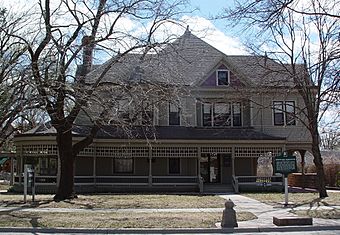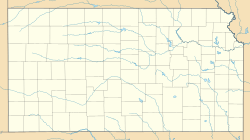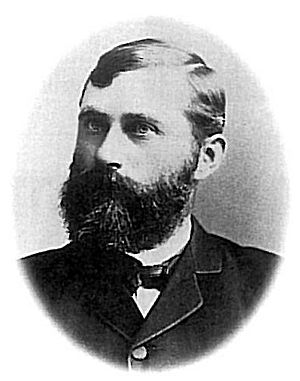Warkentin House facts for kids
Quick facts for kids |
|
|
Warkentin House
|
|

Warkentin House
|
|
| Location | 211 East 1st Street, Newton, Kansas |
|---|---|
| Built | 1886 |
| Architectural style | Late Victorian |
| Website | Website |
| NRHP reference No. | 70000250 |
| Added to NRHP | January 12, 1970 |
The Warkentin House is a historic home located in Newton, Kansas, United States. It was built for Bernhard and Wilhelmina Warkentin between 1886 and 1887. This beautiful house is a great example of Victorian period architecture and design. Today, it's a museum where you can see how the Warkentin family lived. About 80% of the furniture and items inside are original to the house!
Contents
The Warkentin Family Story
Bernhard Warkentin was born in Ukraine on June 18, 1847. In 1872, he traveled to the United States. He wanted to learn about farming, business, and government in the country.
Wilhelmina Eisenmayer was born in Illinois on November 1, 1852. She and Bernhard got married on August 12, 1875. They had two children: Edna Wella, born in 1876, and Carl Orlando, born in 1880.
How Kansas Became a Wheat Powerhouse
Bernhard Warkentin played a big part in making Kansas famous for wheat. He understood that Mennonite farmers would be very helpful to the Great Plains states. Railroad companies also wanted people to settle in the Midwest.
Between 1874 and 1884, about 15,000 Mennonites moved to America. Most of them settled in Kansas. Bernhard Warkentin encouraged these new immigrants to bring a special type of wheat with them. It was called Turkey Red hard winter wheat.
In 1873, Warkentin moved to Halstead, Kansas. He built Harvey County's first flour mill there. He also built his own farm by the Little Arkansas River. While planning his mill, Warkentin visited other mills. He met Wilhelmina at her father's mill in Illinois.
In the fall of 1874, Turkey Red wheat was planted in Kansas for the first time. This strong wheat grew very well and produced a lot. It helped Kansas become known as the "breadbasket of the world."
Bernhard Warkentin's Businesses and Legacy
Bernhard Warkentin owned mills and grain elevators in Newton and Halstead, Kansas. He also had one in Blackwell, Oklahoma. He helped start several important places. These included the Halstead State Bank and Kansas State Bank. He also helped create Bethel Deaconess Hospital and Bethel College.
Sadly, Bernhard Warkentin died in 1908 during a trip. Wilhelmina Warkentin continued to live in their Newton home. She lived there until she passed away in 1932.
After Wilhelmina's death, she left the house to the Bethel Deaconesses. They used the house until 1970. Then, a group took over to restore and care for the house. The house was also added to the National Register of Historic Places. In 1973, the city of Newton took ownership. They still run the house as a museum today.
Inside the Warkentin House
The Warkentin House is filled with amazing details. It shows how people lived in the late 1800s.
The Grand Entrance: Foyer
- The front door has a special glass panel. It was cut and etched in France.
- English carpenters created the beautiful wooden details. You can see this on the main staircase. There is also fancy carved wood, called fretwork, in the foyer.
- Near the front door is a small bathroom, called a lavatory. Travelers could clean up there. It has an English cabinet and an Italian marble sink. The towel holder looks like a lion's head and is from England.
- The walls in the foyer and stairwell have fancy leatherette wainscoting. This is a type of paneling that covers the lower part of the walls.
Parlor and Music Room
- The fireplace in the parlor has a cherry wood mantelpiece. The tiles around it are from Italy.
- A special sofa, called a loveseat, shows Chinese design. It has carved dog's heads and claw feet.
- Another sofa, a box sofa, was made in England. The molding around the ceiling matches its design.
- The woodwork in the parlor is cherry-finished walnut. The music room has oak wood. The dining room has walnut. The sliding doors between the music room and dining room are made of two different woods. Each side matches the room it faces.
- Both the music room and parlor have sparkling crystal chandeliers. They came from Czechoslovakia.
- The upright piano in the music room belonged to Edna, the Warkentins' daughter. The floor is covered by a beautiful Anglo-Persian carpet.
- The music room is bright and open. It has many windows on the east and south sides.
Dining Room and Kitchen
- The Italian tiles on the dining room fireplace show the goddess of farming. She is called Demeter in Greek mythology or Ceres in Roman stories.
- The Warkentins loved to entertain guests. Their china cabinet holds some of their original dishes. A special chocolate pot is one of the most interesting pieces.
- The stained glass windows next to the fireplace are even older than the house. They are thought to be from Russia.
- A large design on the wall covering matches the designs on the chandelier and wall lights.
- Life in the kitchen was not as fancy as the rest of the house. Electricity was added soon after the house was built. But the old wood and coal stove was used for many years.
- Indoor plumbing was put in two years after the house was finished. A servant would pump water up to a large tank in the attic each morning. The three sinks in the kitchen are made of slate.
Bedrooms
- The main bedroom area has two rooms. There is a sitting room next to the bedroom. The furniture in the sitting room is made of birdseye maple. It is original to the house.
- The brass double bed in the northwest bedroom also belonged to the Warkentins. Many of the other bedroom furniture pieces are not original. A trunk at the end of the bed was used by the Warkentins when they traveled.
- The parquet floors throughout the house are made of different woods. They are very well crafted. The most unique floor covering is in the main bedroom area. Bright red Russian rugs, which used to be in the music room, are now there to protect them. Bernhard Warkentin bought these rugs in Russia. The thistle pattern on them is Russia's national flower.
Library
- The library has a very unique fireplace. The tiles are Italian. The hearth, which is the floor of the fireplace, has a special diagonal pattern.
- Bernhard Warkentin's roll-top desk is no longer in the library. But his wife's oak writing desk is there now. His favorite chair has cool lion's heads on the arms and claw feet. The design on the coal bucket is like the design on the front door's glass. The walnut library case is one of the few pieces of furniture made in Kansas. It was built in Leavenworth and holds the family's books.





